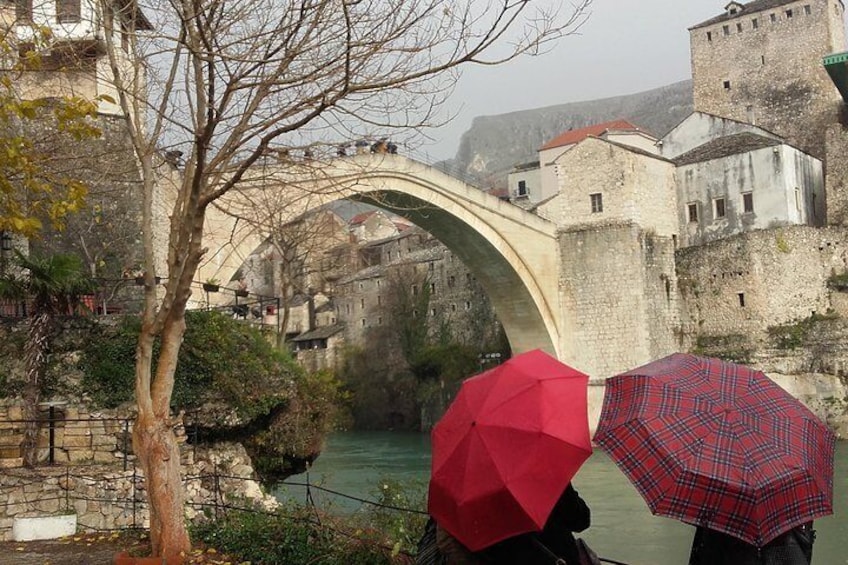
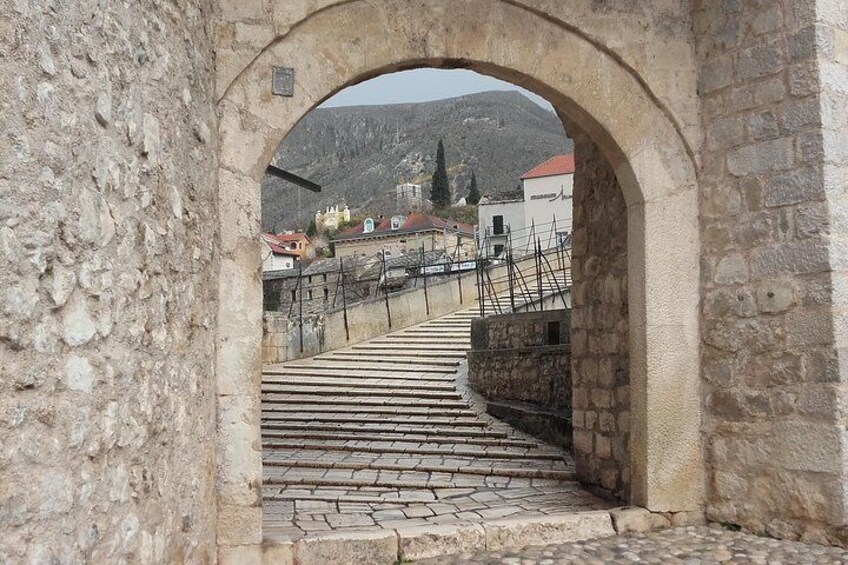
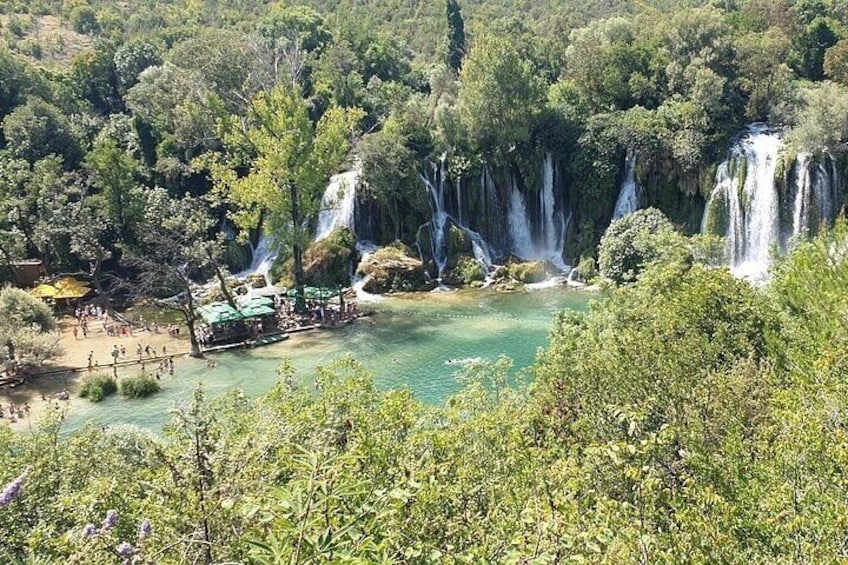
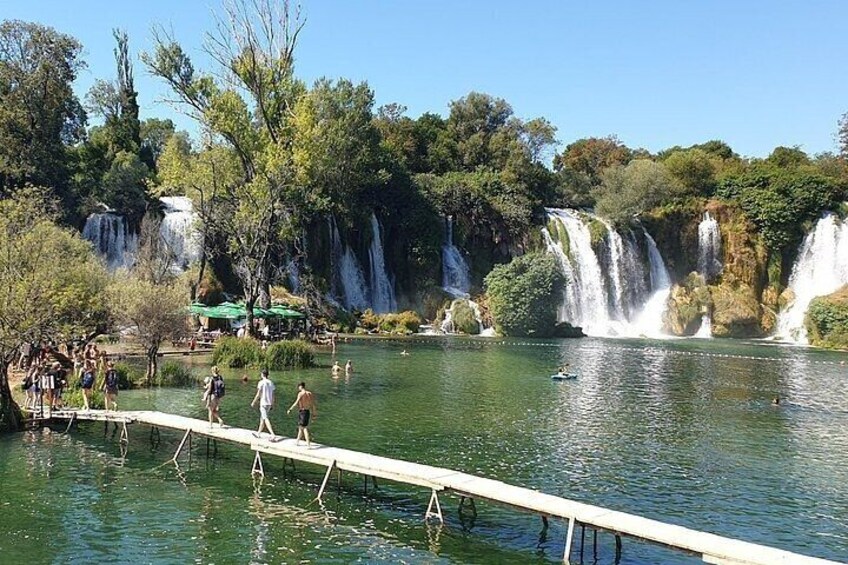
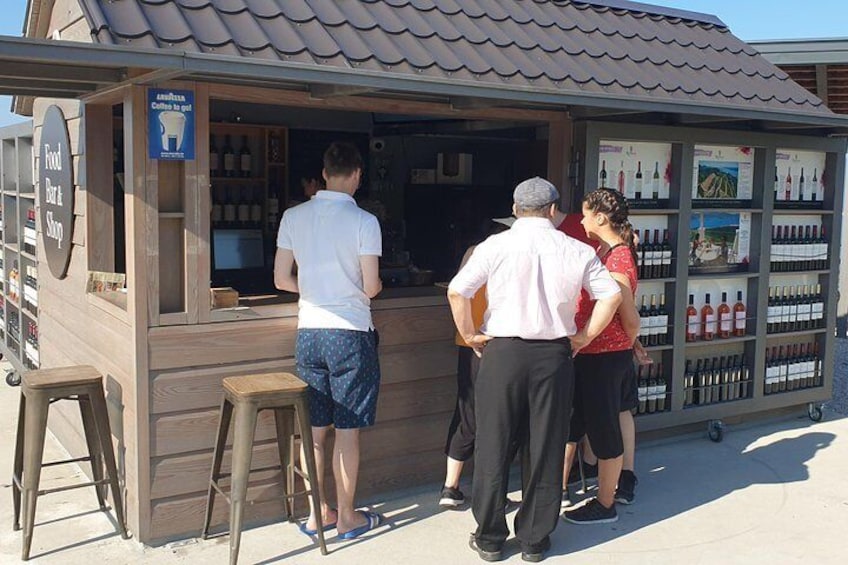
Private Tour: Mostar & Kravice Waterfall day tour from Dubrovnik
By MG Dubrovnik Travel Agency
Free cancellation available
per traveller*
*Get lower prices by selecting more than 2 adults
Features
- Free cancellation available
- 11h
- Mobile voucher
- Instant confirmation
- Selective hotel pickup
Overview
While in Dubrovnik, head to another country for the day to see the best of Bosnia and Herzegovina on a guided day trip. Stop in Neum, Bosnia’s only coastal town, and then continue on to UNESCO-protected Počitelj, which boasts beautiful historical sites. Later, head to Medjugorje, the place where, in 1981, six children saw an apparition of the Virgin Mary and has been one of the most popular spots for Catholic pilgrimage in the world. Finally, continue on to Mostar with its stunning bridge.
Day trip to Bosnia and Herzegovina from Dubrovnik
Visit the UNESCO World Heritage-listed Pocitelj city centre
Enjoy a Medjugorje, an important pilgrimage location for the Catholic world
Activity location
- Mala Kravica
- Trebizat river
- Ljubuski, Bosnia and Herzegovina, Bosnia and Herzegovina
Meeting/Redemption Point
- Mala Kravica
- Trebizat river
- Ljubuski, Bosnia and Herzegovina, Bosnia and Herzegovina
Check availability
Private Tour: Mostar & Kravice Waterfall day tour from Dubrovnik in English
- 11h
- Opening hours: Fri 07:30-18:00
- English
Pickup included
Language options: English
Price details
€480.00 x 1 Traveller€480.00
Total
*Get lower prices by selecting more than 2 adults
Until Thu, 16 Jan
What's included, what's not
- Hotel pickup and drop-off
- English Speaking Driver
- Air-conditioned vehicle
- Service charge
- Lunch
Know before you book
- Public transport options are available nearby
- Suitable for all physical fitness levels
- In accordance with EU regulations about consumer rights, activities services are not subject to the right of withdrawal. Supplier cancellation policy will apply.
Activity itinerary
Mala Kravica
- 1h
- Admission ticket not included
KRAVICA WATERFALL LJUBUŠKI
In the area of Ljubuki there is a unique natural beauty built by the water of the river Trebizat, passing through limestone terrains and depositing tufa. According to many visitors, praised as one of the most beautiful natural attractions, the Kravica waterfall is a recognisable symbol of Ljubuski and Herzegovina.
Mostar
- 2h 30m
Explore Mostar’s UNESCO World Heritage-listed Old Town on this walking tour and benefit from the undivided attention of a private guide. As you admire the city’s medieval buildings and historic monuments, learn about its long history, from the Ottoman Empire to the communist-era as part of former Yugoslavia, and its role in WWII, the Cold War, and the Yugoslavian War.
Pocitelj
- 20m
The historic urban site of Počitelj is located on the left bank of the river Neretva, on the main Mostar to Metković road, to the south of Mostar, in the territory of Čapljina Municipality.
In the middle ages, Počitelj was the administrative centre and centre of governance of Dubrava župa (county), and its westernmost point, which gave it major strategic importance. It is supposed that the fortified town and its attendant settlements were built by Bosnia's King Stjepan Tvrtko I in 1383.
The walled town of Počitelj evolved over the period from the sixteenth to the eighteenth centuries. Architecturally, the surviving stone-built parts of the town are a fortified complex, in which two stages of evolution may be observed: mediaeval, and Ottoman.
The first documented reference to the town dates from 1444, in Charters issued by Kings Alfonso V and Friedrich III. During the period 1463-1471 the town held a Hungarian garrison. Following a brief siege in 1471, the town fell to the Ottomans, and was to remain within the Ottoman Empire until 1878. From 1782 to 1879 it was the centre of a kadiluk (area under the jurisdiction of a kadija or qadi - judge) and from 1713 to 1835 it was the headquarters of the Počitelj military district.
The significance and appearance of the town has altered during the course of its history. Three periods seem to be significant for the development of Počitelj:
1. The time of the Hungarian King Matthias Corvinus when the town had significant strategic importance (1463-1471),
2. The period of development of the settlement under the Ottoman Empire with the erection of typical public buildings: mosques, mekteb (Muslim primary school), imaret (charitable kitchen), medresa (Muslim high school), hamam, Turkish baths, han (inn) and sahat-kula (clock-tower) (1471-1698). During this period military conflicts occurred in more remote areas.
3. The period of recovery of its strategic importance after the Venetians conquered and destroyed Gabela (1698-1878).
With the establishment of Austro-Hungarian rule in BiH in 1878, Počitelj lost its strategic importance and began to deteriorate rapidly. The loss of the town's strategic role helped to safeguard the original urban architectural ensemble, so that the town has been preserved in its original form to this day.
During the 1992-96 war in BiH the entire historic urban site of Počitelj and all its various buildings suffered extensive war damage.
In 1996, Počitelj was named by World Monuments Watch as one of the world's 100 most endangered cultural heritage sites, as proposed by the University of York, United Kingdom, and the University of Sarajevo, in the light of its outstanding value.
In 2000 the Government of Federation of Bosnia and Herzegovina started the Programme of the permanent protection of Počitelj that comprises of: protection of cultural heritage from further deterioration, rehabilitation of damaged and destroyed buildings, returns of the refugees and displaced persons to their homes and the sustainable and long-term protection and revitalisation of the Historic urban area of Počitelj. The Programm is on-going and now it is in the stage of rehabilitation of housing complexes in the upper part of Počitelj.
ARCHITECTURE
FORT - The fort of Počitelj was built between the fifteenth and eighteenth centuries, with intervals when construction was suspended. The original mediaeval nucleus of the fort is the oldest walled section, where two stages of construction can be identified: the older, inner town or fortress (a donjon tower with a small ward or bailey) from the late fourteenth century, with later additions, alterations and reinforcements dating from the second half of the fifteenth century. To judge from the layout of the oldest parts of the fortress it may be assumed that there was a small settlement below the fortifications, dating from an earlier or the same period as the fortifications themselves. Somewhat prior to 1698, the fortress was considerably enlarged and fortified with a stronger system of defence. The town was walled so as to form an inner bailey from the square tower, two bastions (Mehmed-paša's and Delibaša's), Dizdar's house, a granary, the fort's mosque and a "water-tower" - a cistern with an entrance and steps leading to the water, two large gateways and two small ones. During the 1992-96 war in BiH the fortress suffered no serious damage.
MOSQUE OF ŠIŠMAN IBRAHIM-PAŠA - or Hadži Alija's mosques is one of the finest achievements of the classical Ottoman style of single-room domed mosques in BiH. According to its chronogram, it was built in 970 AH (1562-63 AD) by Hadži Alija. The mosque occupies a prominent position in the urban fabric of the town and its natural surroundings. Other public buildings located by the mosque are the mektebs, the imaret, the medresa, the hamam, the han and the clock-tower. The mosque was blown up in 1993: the dome and minaret were demolished, and the rest of the building was badly damaged. As a part of Programm of the permanent protection of Počitelj the mosque was rehabilitated and now it is returned to its original function.
MEDRESA (Muslim religious high school) OF ŠIŠMAN IBRAHIM-PAŠA - Evlija Čelebi's travel chronicle makes it clear that the medresa in Počitelj dates from before 1664. It belongs to the standard type of smaller religious school, with five classrooms and a lecture room ranged along the two sides of an inner courtyard. The classrooms are roofed with five small domes and the lecture room with one large one. During the 1992-96 war in BiH the medresa was damaged by shelling. As a part of Programme of the permanent protection of Počitelj the medresa was rehabilitated.
HAMAM (the baths) - It may be concluded from Evlija Čelebi's travel chronicle that the baths were built prior to 1664, and that they were built by craftsmen sent from Istanbul for the purpose.
The hamam is typical of smaller public baths. As a part of Programme of the permanent protection of Počitelj the hamam was rehabilitated.
HAN (inn) OF ŠIŠMAN IBRAHIM-PAŠA - was built around 1665. It was of the single-storey han type, built around a central area where horses were stabled. Little has survived of the original structure of the han: the remains of an arched gate of finely dressed cut stone with parts of the outside walls to the left and right of the entrance, parts of the outside wall opposite the entrance; some remains of the raised podium (for travellers to take rest); all of this recorded prior to 1960. The object was renovated in the 1970s to be used for catering purposes.
SAHAT-KULA - CLOCK-TOWER - Since Evlija Čelebi's travel chronicle makes no reference to the sahat-kula, it is assumed that it was erected at a date later than 1664. It is typical of clock-towers in Herzegovina, which arose under the influence of Mediterranean-Dalmatian architecture. It is stone-built, with dressed quoins and ending in a stone pyramid. There are four pointed arches on the four sizes above the opening near the top of the tower. This type of sahat-kula is to be found in Počitelj, Mostar, and Stolac.
HOUSING - Stylistically, the residential architecture of Počitelj is a blend of Mediterranean and Oriental elements with certain local features. The influence of Mediterranean architecture is to be seen in the use of gable roofs, the pronounced stone wall structure, small, widely separated windows, and the arrangement of the rooms in fairly small, single-storey buildings. The influence of Oriental architecture is reflected in the use of hipped roofs, doksats or oriel windows, rows of close-set windows, the arrangement of rooms with a hajat (anteroom) on the ground floor and an open divanhan (sitting room) on the ground floor, and the interconnected enclosed courtyard and interior living quarters. The basic building material was stone. Typical common features are round chimneys and roof cladding of irregularly shaped stone slabs. All the houses had privies in the courtyard and a hamamdžiluk (small bathroom) in the musandera (built-in carved wooden structure incorporating cupboards and occupying the entire wall of the main room). Wealthier households had a bathroom in every room. All the houses in the town were laid waste during the 1992-96 war in BiH. As a part of Programme of the permanent protection of Počitelj the mosque was rehabilitated and now it is returned to its original function.
THE GAVRANKAPETANOVIĆ HOUSE - is a group of buildings consisting of two smaller and one larger building (with the division into selamluk and haremluk) built during the course of the sixteenth and seventeenth centuries. In size it is the largest and most highly evolved example of the residential architecture of Počitelj. A characteristic of the building is the use of arched windows on the west facade. By the mid twentieth century the buildings had been abandoned and were deteriorating badly, as a result of which, in order to preserve and renovate the building, a project to convert it to an artists' colony was launched in 1961 and completed in 1975. The central building was converted to accommodation for the artists. During the war the complex was set on fire and laid waste in 1993. The most serious damage was to the haremluk, to the wooden post-and-pan construction and wooden cladding. As a part of Programme of the permanent protection of Počitelj the Gavrankapetanović housing complex was rehabilitated and now it is returned to the function of Artists' colony.
Location
Activity location
- Mala Kravica
- Trebizat river
- Ljubuski, Bosnia and Herzegovina, Bosnia and Herzegovina
Meeting/Redemption Point
- Mala Kravica
- Trebizat river
- Ljubuski, Bosnia and Herzegovina, Bosnia and Herzegovina
Best Deals on Things to Do
Experience the wonders of the world up close with great deals on things to do near and far. We offer one-of-a-kind activities that allow you to explore Ljubuski your way. Whether you love nature, culture, food or a bit of adventure, we have the perfect activity for you.